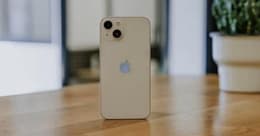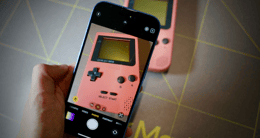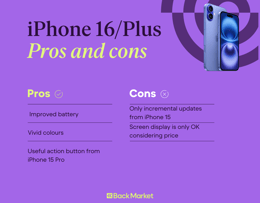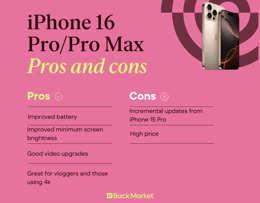
Should I Still Buy an iPhone 13? - The Complete Buyer's Guide
Is the iPhone 13 still any good in 2024? Read our full review for all the features and specs you need to know before buying an iPhone 13.

Get our take on Apple's most talked-about iPhone of 2024 as we take a look at the new 16 series. Find out whether it’s worth the splurge.
Whether you’re into new tech or not, Apple’s release of the iPhone 16 was one of the most talked-about electronic releases in 2024. But it wasn’t all good press. Following the brand’s Keynote speech on September 9, critics and consumers took to social media to claim that the latest generation of devices lacked innovation.
We wanted to make our minds up for ourselves and share our insights in this comprehensive guide. Here, we’ll talk you through everything iPhone 16 and iPhone 16 Pro, reviewing and comparing them with other models and manufacturers. From price point to performance, design to display – here’s the inside scoop.
So, how have things leveled up? With the iPhone 16 and iPhone 16 Pro, there are improvements and tweaks across the board. The biggest thing on people’s lips is the new Apple Intelligence, Apple’s own AI (artificial intelligence) which will be built into new updates of the iPhone, iPad, and Macs.
The big development is that AI will be bespoke to each user. It will use your behaviors to write and create original images, making activities easier without giving anyone access to this data (including Apple). Siri will now also be using AI to improve its virtual assistance too – kinda neat or spooky, depending on how you look at it.
But there’s one small hitch – Apple Intelligence isn’t actually out yet. In fact, it isn’t expected to launch until the end of this year with only some of the listed features, first launching in the US, then rolling out in other regions. It’s one of the most anticipated and techie new features of the latest iPhones, and anyone buying one will certainly get a stab at playing around with AI at some point. But if you want to buy the newest model right now, a couple of months long wait probably doesn’t sound all that appealing.
Currently, the developer beta of iOS 18.1 is being used to test these new features, though expect the rollout to come with its fair share of bugs and performance issues
So, what does the new iPhone have to offer immediately?
Remember the iPhone 15 and 15 Pro launch? That marked the beginning of Apple's pivot to USB-C charging. The 16 Pro supports faster USB 3.2 Gen 2, which is quicker than the USB-C connectivity seen prior (unfortunately, the regular iPhone 16 still has the older USB 2 version). It also offers convenience compared to the iPhone 14, especially in the long term as lightning cables will be phased out.
In terms of appearance, the iPhone 16 has brighter and more saturated color finishes than its predecessor, admittedly standing out far more than the muted colors on the iPhone 15. The standard iPhone 16 model and the iPhone 16 Plus come in some cute colors too: black, white, pink, teal, and ultramarine, if you’re feeling bold. And if you’re looking at the 16 Pro, this phone introduces a new "desert sand" finish, along with the more subdued and metallic finishes previously seen – black titanium, white titanium, and natural titanium.
If you’re prone to dropping your phone, it might be the one for you. The new iPhones also feature aerospace-grade aluminum, a durable ceramic shield front that has been upgraded from the previous model. Good for clumsy hands.
When it comes to size, the iPhone 16 and iPhone 16 Plus have the same dimensions as last year's models, at 6.1 inches and 6.7 inches respectively. The iPhone 16 Pro and iPhone 16 Pro Max are slightly larger at 6.3 and 6.9 inches – the latter great for those who like a big screen, but also kind of chunky for those who don’t.
But the weight changes are pretty marginal. The heaviest iPhone 16 model is the Pro Max at 227g, while the iPhone 16 Pro Max is 170, a gram lighter than the standard iPhone 15 model. The rest all slot somewhere between. In practical terms, it’s not very noticeable.
All models also contain the action button that was introduced with the iPhone 15 Pro. Finally, a new addition across the lineup is a ‘camera capture’ button. This new button allows you to capture a photo with something that feels more like a shutter (and at a half-click, you can bring it up in Settings). But truthfully, this isn’t going to be a transformative innovation for many people. It’s also on the left-hand side, meaning left-handers out there might click it more than they wish to.

This is where a caveat comes in. Sadly, the core iPhone 16 is limited to a 60Hz refresh rate, which was found on the iPhone 15. This isn’t really acceptable for a device at this price point in 2024. To explain, let’s compare a little. The Samsung S23 has a refresh rate of 120Hz. The 16 Pro also has a 120Hz (ProMotion) display, but this was also found on the older 15 Pro. So if you want a screen with the same quality, you might as well buy an older, cheaper version of the phone.
But there are other improvements. Across the board, the minimum brightness has been improved, which makes for a better nighttime experience. The iPhone 16 and 16 Plus do not have the always-on screen you find on the iPhone 15 Pro and 16 Pro, which is a handy feature that many users of the 15 Pro have enjoyed – though that can be a personal preference.

The iPhone 16 is powered by the A18 processor, with 8 GB of RAM for the 16 Pro. However, since the iPhone 13, processor power has not been a significant issue for average users – the phones are more than capable of handling just about any task you throw at them. But still, there’s a bit more RAM in there, likely to help the eventual AI function locally.
The battery life on iPhone 16 and 16 Plus has seen improvements in how it’s physically installed into the device. In simple terms, the battery is glued into the phone in a way that’s much easier to repair than before. Unfortunately, this isn’t available on the Pro models, but likely a sign of things to come in the future. In terms of performance, the iPhone 16's battery life allows it to sustain daily activities more efficiently, with benchmark results showing notable improvements over the iPhone 15 (Apple claims an extra 2 hours of video playback on the iPhone 16 over the 15). Initial feedback also suggests Apple has resolved many of the overheating issues present with the iPhone 15. Charging capabilities are also suggested to be as high as 45W for wired charging, but this is yet to be confirmed.

Here’s where the bigger changes are at the moment. The new iPhone 16 models excel in terms of recording video, particularly the iPhone 16 Pro which supports 4K at 120 fps (frames per second), and has a much improved audio mixing system. Vloggers and videographers are really going to enjoy these features. Plus, the iPhone 16 Pro has a 48-megapixel ultrawide camera, which allows for far better ultrawide photos than the basic 16 model (though is quite similar to the 15 Pro).
The inclusion of a dedicated telephoto camera in the iPhone 16 Pro enhances zoom capabilities, making it ideal for users looking to capture distant subjects with higher clarity.
The iPhone 16 Pro also has a faster camera sensor than we have seen with Apple before, minimizing annoying shutter lag. Otherwise, much is the same – the computer-correcting is still there, which some may like, but the more discerning photographer could find annoying. Thankfully, there are more “photographic styles” to play with in the iPhone 16 Pro. But to get the best of it, you’ll have to shoot using HEIF (High Efficiency Image Files).
The iPhone 16 introduces a new Camera Control button, giving users more control over their photography and videography. It’s not exactly life-changing, but it does allow you to cycle through different camera modes, scroll through Photographic Styles, and even initiate video recording with a simple press. It might have some convenience value for photography buffs as the camera app is more intuitive, but at the end of the day, this is more of a redesign rather than an improvement in the actual camera performance.
Specs: | iPhone 16 | iPhone 16 Plus | iPhone 16 Pro | iPhone 16 Pro Max |
Display: | 6.1 inch, 60 Hz, OLED, 2,000 nits | 6.7 inch, 60 Hz, OLED, 2,000 nits | 6.3 inch, 120 Hz (ProMotion), OLED, 2,000 nits, always-on display, | 6.9 inch, 120 Hz (ProMotion), OLED, 2,000 nits, always-on display |
Processor: | A18 | A18 | A18 Pro | A18 Pro |
Storage: | 128, 256, 512 GB options | 128, 256, 512 GB options | 128, 256, 512 GB, and 1 TB options | 256, 512 GB, and 1 TB options |
Cameras: | 48-MP main camera, 12-MP ultrawide with Macro | 48-MP main camera, 12-MP ultrawide with Macro | 48-MP Fusion camera, 48-MP ultrawide with Macro, 12-MP telephoto with 5X zoom | 48-MP Fusion camera, 48-MP ultrawide with Macro, 12-MP telephoto with 5X zoom |
USB-C speeds: | USB 2, up to 480 Mb/s | USB 2, up to 480 Mb/s | USB 3, up to 10 Gb/s | USB 3, up to 10 Gb/s |
Colors: | Pink, Teal, Ultramarine, White, and Black | Pink, Teal, Ultramarine, White, and Black | Black, White, Natural, Desert | Black, White, Natural, Desert |
Material: | Aluminum | Aluminum | Titanium | Titanium |
Price*: | $829 | $929 | $999 | $1,199 |
*Prices found on the Apple Store for the price of a new iPhone 16 as of writing this article. Subject to change.
As this all implies, the differences are marginal, aside from Apple Intelligence and the camera’s improved functionality. Of course, for those looking for a phone to assist their video-making, the improved battery, USB-C port, and camera performance does make the Apple iPhone 16 models attractive. Both the Apple iPhone 15 and 16 do improve from the 14 models, especially when considering Pro models. But for the majority, the iPhone 16 is an incremental upgrade from the iPhone 15 at best, at least for now.
These phones will burn a hole in your wallet – the price of a brand new iPhone 16 via Apple starts from $999 while the Pro Max starts from $1,199, going up to $1,599 if you want 1TB of internal memory. The iPhone 15 comparatively starts at $699, while a refurbished iPhone 15 Pro is available from $638 on Back Market.
Generally, the iPhone 16 doesn’t offer anything unique to justify the price point over the iPhone 15 or even 14. While the improved battery life might be appealing, it’s a minimal change for most iPhone users, so the upgrade seems unnecessary. That said, some photographers and videographers might appreciate the new Camera Control button and the enhanced camera system. Aside from that, if you’re waiting for the new Apple Intelligence features, they will also be released on the iPhone 15 Pro models, which you can get for significantly less than the iPhone 16.


While the iPhone 16 and 16 Pro are solid smartphones boasting good cameras, functionality, and the promise of far more in the future, it’s debatable whether these massively improve on what the iPhone 15 already offers. There are also minimal differences between the iPhone 16 and 16 Pro compared with previous Pro and standard models.
Apple’s new phones may confirm what a lot of us are thinking – that upgrading your smartphone annually makes less sense, and a change every three to five years probably feels more reasonable. If you’re really keen to have a newer device, we’d recommend considering an iPhone 15 Pro for now, and waiting for more revolutionary models to arrive in the coming years.
You’re probably here because you’re considering a refurbished iPhone instead of the newest Apple model. And of course – we’re with you! Refurbished doesn’t mean less quality, and there’s no risk for you as a buyer – you get the same 1-year warranty provided that you get when buying brand new, plus a hassle-free returns period of up to 30 days. Plus, there are plenty more benefits to choosing a refurbished phone. Of course, they’re often cheaper than brand-new, saving you money. But it’s also a much more sustainable and eco-friendly buying choice that helps the planet.